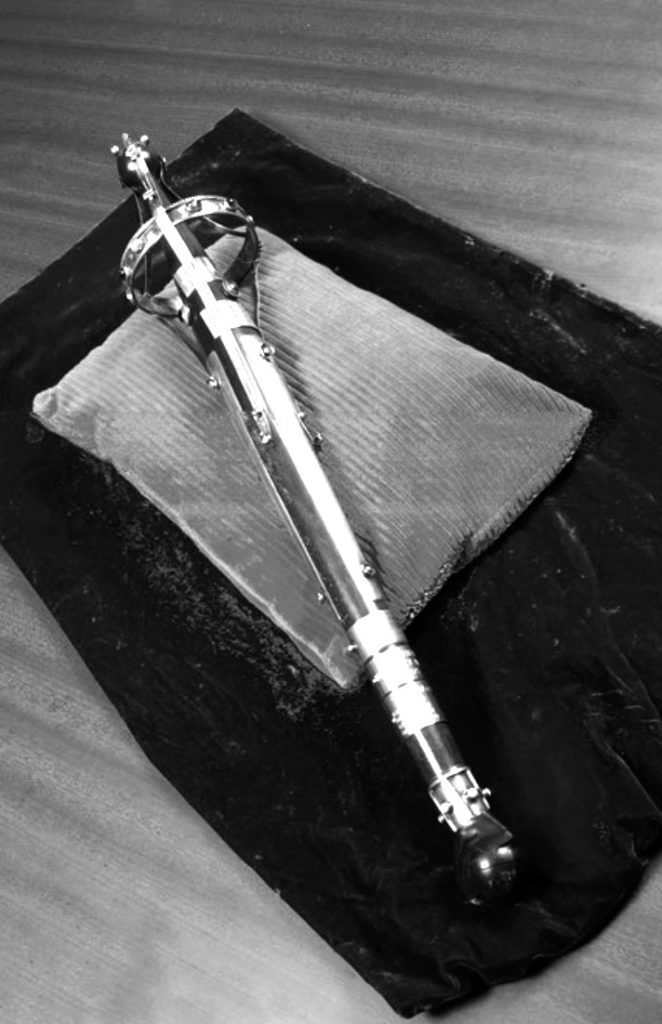The mace (Arabic, amūd; Latin, mascea) was originally a weapon: a short handle topped with a metal ball, its bludgeoning force eclipsed that of a club. A common sight in medieval armies, the mace also served as a symbol of authority, appearing on the seals of such monarchs as Edward the Confessor, Philip Augustus, and Frederick Barbarossa.
In academic settings, a bedellus (lay church official) processed with the mace during commencement; hence, it was adopted by colleges and universities throughout the West and, in the United States, is usually borne by the Chief Faculty Marshal in academic processions.
The Morgan State University Mace is made of wood from one of the oldest buildings that existed on campus, a polished stone from the campus quarry, and three silver strips, each engraved with an epoch of Morgan’s history. It is decorated with silver clasps and semi-precious stones. It was a gift to the University from the General Alumni Association (June 4, 1956).
The Mace was designed and executed by the late Dr. Charles W. Stallings, formerly of the Morgan State College faculty in the Department of Art.
The University Mace
Morgan State University Maces

Chief Faculty Marshals of the University
1914-1948: Dr. Milton L. Calloway
1948-1966: Dr. George H. Spaulding
1966-1974: Dr. Nathaniel K. Proctor
1974-2009: Dr. Clayton C. Stansbury
2009-present: Dr. Milford A. Jeremiah

The New University Mace
During its Sesquicentennial Celebration—December 2016 to December 2017— Morgan State University is retiring its sixty-year-old mace and replacing it with a longer mace that will be able to accommodate the names of additional Presidents over the years and that displays more prominently the insignia of the four major periods of its development: Centenary Biblical Institute, Morgan College, Morgan State College and Morgan State University. The new mace, crafted by the Medallic Art Company in Dayton, Nevada, has a 36-inch-tall fluted mahogany staff with 14 antique brass banners encircling it, the first ten engraved with the names and terms of the inaugurated presidents of the University. The mace head is a four-sided mahogany crown that bears images of three iconic Morgan structures and, on one side, the seal of the University, all in bronze, and, at its top the traditional flame of knowledge. The base of the mace is adorned with a tiered brass foot. The new Mace was designed by the Sesquicentennial Celebration Coordinating Committee, and it is a Sesquicentennial Gift to the University from the MSU Alumni Association.
The Sesquicentennial Mace
The Sesquicentennial Mace, crafted by the Medallic Art Company in Dayton, Nevada, was commissioned by the Sesquicentennial Celebration Coordinating Committee for Morgan’s 150th-Anniversary Celebration. Similar to the New University Mace, it has a 54-inch-tall fluted mahogany staff with 10 antique brass banners encircling it, bearing the names and terms of the inaugurated presidents of the University. The mace head is a four-sided mahogany crown that bears images of three iconic Morgan structures and, on one side, the seal of the University, all in bronze, and, at its top, is a three-inch bronze medal bearing the Sesquicentennial Logo, against a mahogany background, which is surrounded by brass leaves. The base of the mace is adorned with a tiered brass foot. After the Sesquicentennial Celebration, the Sesquicentennial Mace will be retired, put temporarily on display in Richardson Library and, thereafter, assigned to the Archives of the University in the Beulah Davis Special Collections Room.


